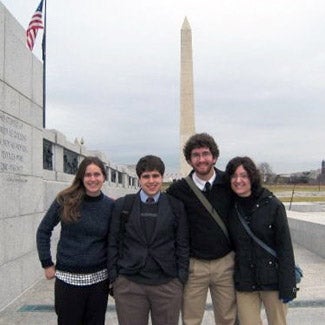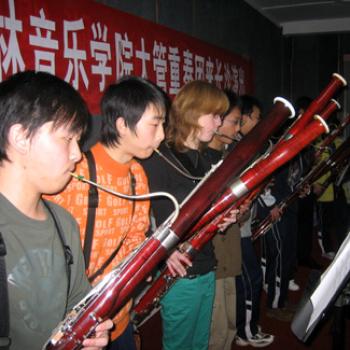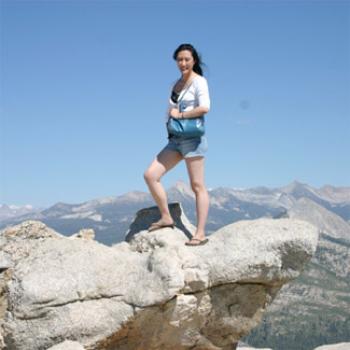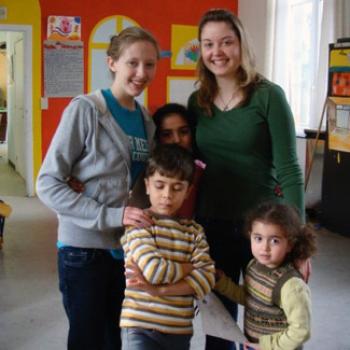On organizing a winter term project about coal’s life-cycle effects in central Appalachia
Benjamin Jakubowski ’11
“thanks to the strength of the Oberlin community and the support that is so close at hand, the road between imagination and realization isn’t as far as it might seem.”

When I first heard of winter term as a prospective Oberlin student, the idea of spending a month pursuing a project of my own design seemed foreign, even frightening. High school hadn’t offered me that kind of academic freedom, and had left me with the misconception that learning is best achieved through lectures, papers, and problem sets. Fortunately, at Oberlin I rapidly realized that learning doesn’t have to be so formalized; instead, it follows exploration of any kind. That’s what my first winter term offered—a chance for exploration and a glimpse of a piece of America I never expected to see.
During the fall of my first year, the Oberlin City Council was considering buying into a proposed AMP-Ohio coal-fired power plant. While attending city council meetings, I heard both supporters and opponents of the plant raise their concerns. Supporters suggested that unless Oberlin bought into the plant, we would be left high and dry, navigating the open market for base load power. Opponents questioned the prudence of locking Oberlin into a coal-fired future and decried the negative social and environmental impacts plaguing coal’s life cycle.
In this atmosphere of civic debate over the place of coal in Oberlin’s future, I organized a group of 30 Oberlin students to attend Powershift 2007, a November conference of climate activists in Washington, D.C. In Washington, we heard firsthand accounts of the conditions in coalfields and in the communities neighboring coal-fired power plants. Between concurrent sessions and keynotes, it became apparent to three of my friends and myself that understanding coal’s life-cycle effects was critical to becoming effective environmental advocates and informed citizens. Still, we wanted more than the flowchart version of coal’s life cycle— extraction, processing, transport, and combustion —which seemed far too sterile. Instead, we wanted to understand the human dimension of America’s reliance on coal.
To do so, we decided that we needed to spend winter term 2008 meeting with stakeholders along every step of coal’s life cycle; coming from Oberlin, we decided it was appropriate to focus on central Appalachia. In early November, we began setting up meetings and site visits with beltway lobbyists, central Appalachian coalfield activists, utility operators, and coal plant and mine managers. Two months later, we found ourselves with thousands of miles of Appalachian highways between Oberlin and a month of meetings, mine visits, and plant tours.
While the trip provided an incredible introduction to lobbying and environmental justice and everything in between, it also proved the vitality of the Oberlin community. Every aspect of our trip, from planning and financing to housing, was supported by the Oberlin community. Thanks to Environmental Studies Program faculty guidance, my friends and I didn’t set out on the trip completely ignorant of coal’s life cycle or coal’s place in America’s energy portfolio. Thanks to support from the Ann Schaening Memorial Fund, we were able to keep the tank full as we crisscrossed Appalachia. Thanks to the hospitality of alumni all across Appalachia, we spent nights sharing Oberlin stories, instead of in off-ramp hotels; our hosts shared stories of hearing Martin Luther King’s commencement address and living in OSCA in the 1980s, while my friends and I reflected on our first semesters.
Ultimately, my first winter term taught me an important lesson about Oberlin: thanks to the strength of the Oberlin community and the support that is so close at hand for Oberlin students, the road between imagination and realization isn’t as far as it might seem. While the possibility of spending a month studying anything, much less coal’s lifestyle impacts on central Appalachia, seemed far-fetched initially, Oberlin helped make it a reality.
Tags:
You may also like

On organizing a Bassoon Quartet tour of China
“As someone who was reluctant to go to college “in the middle of a bunch of cornfields,” I now can’t imagine having gone anywhere else for school ... no other institution would be so supportive of my...
Joycelyn Eby ’09

On interning at a hedge fund
“I had preconceived ideas of finance as a lofty, entirely mathematical, robotically exact, and overall boring kind of field. In no way, shape, or form would I have predicted that I would end up where...
Juliette Lu ’12

On her Winter Term in a Belgian refugee center
“As cultural and linguistic barriers melted away, each one of us was able to make valuable friendships with the staff and residents of this center that had opened its arms to us and welcomed any new...
Katie Hart ’11